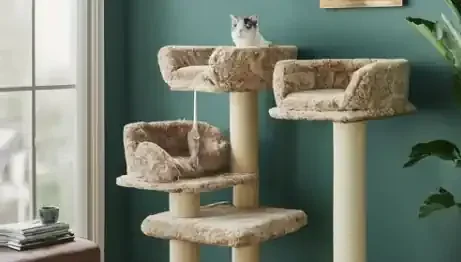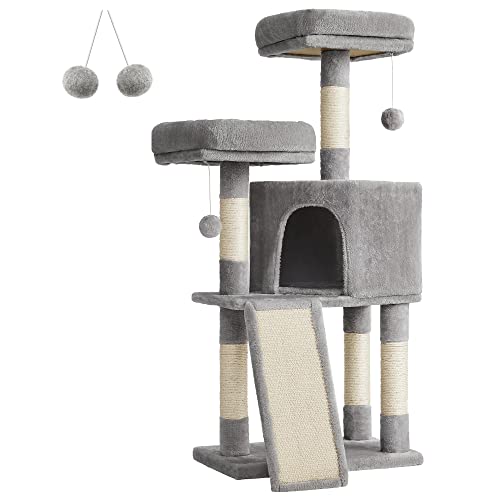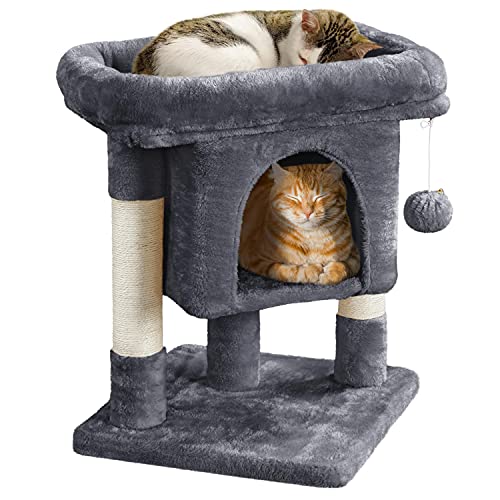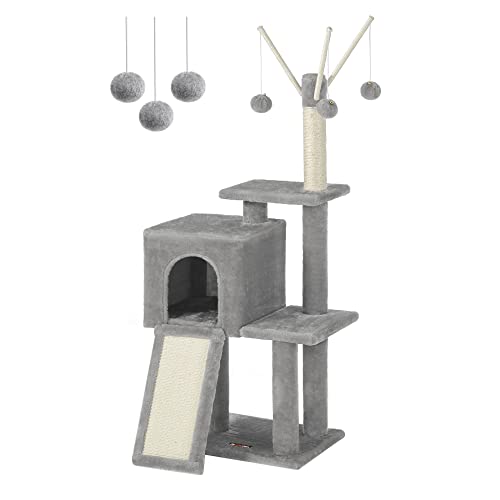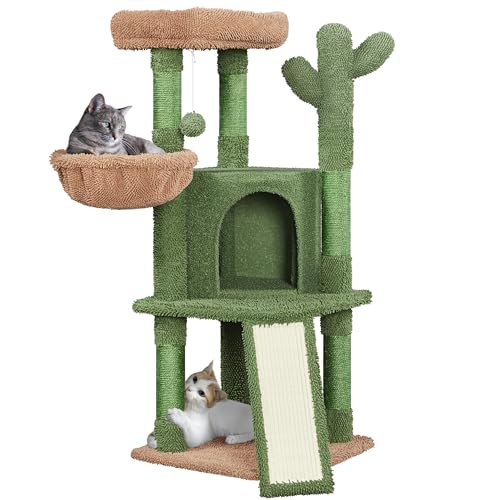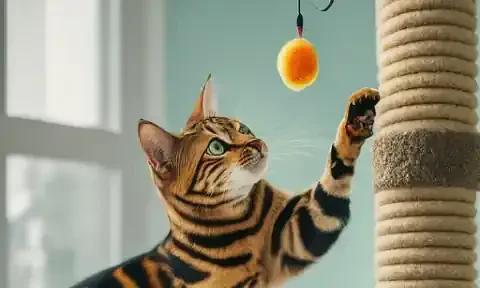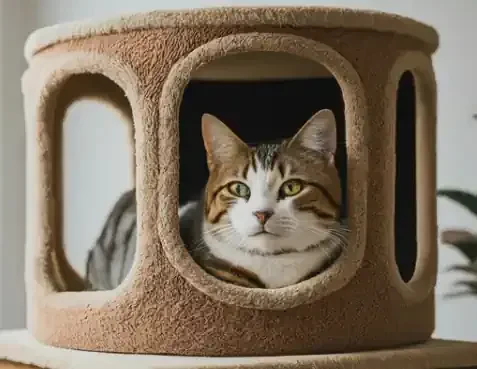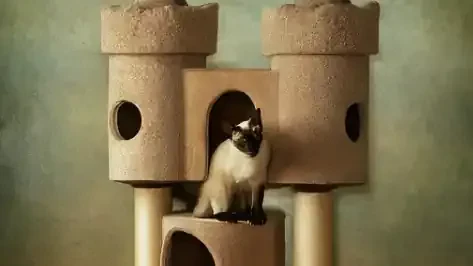Introduction: Why Cat Tree Safety Matters
Your cat's safety is paramount, and their beloved cat tree plays a crucial role in their well-being. While often seen as a fun accessory or scratching post, a cat tree can present hidden dangers if not chosen and maintained carefully. In this comprehensive guide, we'll explore the importance of cat tree safety, uncover potential risks, and equip you with essential knowledge to ensure your feline friend's haven is truly secure.
The Hidden Dangers Of Unstable Cat Trees
A seemingly harmless wobble can quickly escalate into a disaster. Unstable cat trees pose significant risks, leading to falls, injuries, and even fatalities. Cats are agile climbers, but a sudden collapse can catch them off guard, resulting in broken bones, sprains, or worse. Imagine the heartache of witnessing your playful companion suffer due to an avoidable accident.
Common Cat Tree Accidents And Injuries
The statistics are alarming. A study by the American Society for the Prevention of Cruelty to Animals (ASPCA) revealed that falls are the leading cause of feline injuries. Many of these incidents occur from elevated surfaces like cat trees. Torn claws, head trauma, and internal injuries are just some of the potential consequences of a cat tree mishap. By prioritizing safety, you can safeguard your cat from these devastating outcomes.
Beyond Physical Safety: The Importance Of Emotional Security
A cat tree isn't just a plaything; it's a sanctuary. It offers your cat a safe space to observe their surroundings, retreat when feeling overwhelmed, and indulge in their natural instincts to climb and explore. A wobbly or unreliable cat tree can undermine this sense of security, leading to anxiety, stress, and behavioral problems. By providing a stable and secure haven, you're nurturing your cat's emotional well-being.
How A Safe Cat Tree Enhances Your Cat's Well-Being
A safe cat tree is an investment in your cat's overall health and happiness. It encourages physical activity, helping them maintain a healthy weight and muscle tone. The mental stimulation of climbing and exploring promotes cognitive function and prevents boredom. Additionally, the scratching posts on a sturdy cat tree satisfy their natural urge to scratch, protecting your furniture and carpets.
Your Role In Creating A Safe Haven For Your Feline Friend
As a responsible cat owner, you have the power to create a safe and enriching environment for your beloved companion. By understanding the risks associated with cat trees and taking proactive measures to ensure their stability, you're not just preventing accidents; you're fostering a lifelong bond built on trust and security. Your cat deserves a haven where they can thrive, and a safe cat tree is a fundamental part of that equation.
Choosing The Right Cat Tree: A Buyer's Guide
Selecting the perfect cat tree isn't merely about aesthetics; it's a critical decision that directly impacts your cat's safety and enjoyment. With countless options flooding the market, navigating the choices can be overwhelming. Fear not, for this comprehensive buyer's guide will equip you with the knowledge to make an informed decision, ensuring your feline companion thrives in their new vertical playground.
Materials Matter: What To Look For And What To Avoid
The materials used in constructing a cat tree significantly influence its durability, safety, and longevity. Prioritize natural, non-toxic materials like solid wood for the frame and posts, as they offer superior stability and resistance to wear and tear. Opt for sisal rope or fabric for scratching posts, as these mimic the texture of tree bark, satisfying your cat's natural scratching instincts while protecting your furniture. Avoid cat trees made from particle board or cheap plastics, as they are prone to breaking and may contain harmful chemicals.
Stability Is Key: Ensuring A Sturdy Base And Structure
A wobbly cat tree is an accident waiting to happen. Before purchasing, assess the base of the cat tree. A wide, heavy base provides a solid foundation, preventing tipping even when your cat leaps or climbs with enthusiasm. Additionally, examine the overall structure for any signs of flimsiness or loose joints. A sturdy frame will ensure your cat's safety during their arboreal adventures.
Size It Up: Matching The Cat Tree To Your Cat's Needs
Cat trees come in a variety of sizes, from compact models suitable for kittens to towering structures designed for large breeds. Consider your cat's size, age, and activity level when choosing a cat tree. A young, energetic cat will require a taller tree with ample space for climbing and jumping, while a senior cat might prefer a shorter model with easy-to-reach platforms.
Multi-Cat Households: Considerations For Shared Spaces
If you share your home with multiple feline companions, factor in their individual needs and personalities when selecting a cat tree. A multi-level tree with diverse scratching surfaces, perches, and hiding spots can accommodate various preferences and prevent territorial disputes. Ensure the tree is robust enough to withstand the combined weight and activity of all your cats.
Scratching Posts: The Importance Of Durable Surfaces
Scratching is an instinctive behavior for cats, essential for maintaining their claws and marking their territory. A cat tree with multiple scratching posts provides outlets for this natural urge, saving your furniture from destruction. Choose posts made from durable materials like sisal rope, which can withstand vigorous scratching without fraying or unraveling.
Assembly And Placement: Tips For Optimal Safety
Proper assembly and strategic placement are crucial for cat tree safety. Follow the manufacturer's instructions meticulously to ensure all parts are securely connected. Place the cat tree on a level surface, preferably against a wall for added stability. Avoid positioning it near windows, balconies, or other potential hazards.
Budget Vs. Quality: Finding The Right Balance
While it's tempting to opt for the most affordable option, remember that a cat tree is an investment in your cat's well-being. High-quality materials, sturdy construction, and thoughtful design features may come at a higher price point, but they offer long-term value and peace of mind. Research reputable brands, read reviews, and consider your budget to find a cat tree that strikes the perfect balance between quality and affordability.
Assessing Your Current Cat Tree: A Safety Checklist
Even the most meticulously chosen cat tree can degrade over time, transforming from a haven into a potential hazard. Regular assessments are vital to ensure your cat's safety and to catch issues before they escalate. Think of this checklist as a routine health checkup for your cat's favorite hangout spot. Let's delve into the key areas to examine and how to identify potential red flags.
Wobbly Platforms: Signs Of Instability
Cats love to perch and survey their domain, but a shaky platform can quickly turn a regal pose into a perilous tumble. Give each platform a gentle nudge or shake. If you detect any wobbling, creaking, or shifting, it's a clear sign of instability. Tightening screws or adding reinforcement might be necessary. Remember, even minor instability can be amplified by your cat's movements, so address it promptly.
Frayed Materials: Identifying Wear And Tear
Cats are natural scratchers, and their claws can leave their mark on even the most durable materials. Examine the scratching posts, perches, and hammocks for signs of wear and tear. Look for frayed edges, loose threads, or exposed wood. These can pose a risk of snagging claws or causing injuries. Consider replacing worn-out components or covering them with fresh sisal rope or fabric.
Loose Parts: Checking For Potential Hazards
Cats are curious creatures, always eager to investigate and explore. Loose parts on a cat tree can pique their interest, but they can also become choking hazards or entrapment risks. Check for dangling strings, beads, buttons, or any other small objects that could be easily dislodged. Securely fasten or remove anything that could pose a danger.
Tipping Risks: Evaluating Stability
A top-heavy cat tree is a recipe for disaster. When your cat leaps onto a high platform, the entire structure could tip over, causing them to fall. Evaluate the stability by gently rocking the tree from side to side. If it feels unsteady or easily tilts, consider relocating it to a corner or anchoring it to the wall for additional support.
Height And Jump Distance: Are They Appropriate?
While cats are skilled jumpers, their abilities vary depending on age, breed, and physical condition. A senior cat might struggle to reach a high platform, while a kitten might misjudge a jump and injure themselves. Ensure the height of the platforms and the distance between them are suitable for your cat's capabilities. If necessary, modify the tree by adding ramps, steps, or additional platforms to make it more accessible.
Cleaning And Maintenance: Keeping Your Cat Tree Safe
A clean cat tree is a safe cat tree. Regularly vacuuming or brushing the surfaces removes dust, dirt, and pet hair, preventing respiratory issues and allergies. Disinfect the tree periodically to eliminate germs and bacteria. Additionally, check for loose screws, worn-out scratching posts, and any other signs of damage. Addressing these issues promptly ensures that your cat's favorite hangout remains a safe and healthy environment.
By incorporating this safety checklist into your routine, you're not just maintaining a cat tree; you're protecting your beloved feline companion. Remember, a few minutes of inspection can prevent hours of heartache. Prioritize safety, and your cat will reward you with endless purrs and playful antics.
Cat Tree Placement: Location, Location, Location!
The old real estate adage holds true for cat trees too: location is everything. Where you decide to position your cat's arboreal playground can significantly impact their safety, comfort, and overall enjoyment. A well-placed cat tree can become a cherished sanctuary, while a poorly chosen spot can turn it into an ignored piece of furniture. Let's explore the key factors to consider when determining the ideal location for your cat tree.
Avoiding High-Traffic Areas: Reducing Stress And Collisions
Cats are creatures of comfort, and they thrive in calm, quiet environments. Placing a cat tree in a high-traffic area, such as a hallway or near a frequently used doorway, can subject your cat to unnecessary stress and potential collisions with passing humans or pets. Opt for a quieter corner of the room where your cat can relax and observe their surroundings without feeling overwhelmed.
Natural Light: The Importance Of Sunny Spots
Cats are natural sunbathers, and they crave warmth and sunlight. Position your cat tree near a window that receives ample sunlight throughout the day. This will not only provide your cat with a cozy spot to bask in the sun's rays but also offer them a prime vantage point for birdwatching and other outdoor entertainment. The added warmth can also be beneficial for senior cats or those with arthritis.
Away From Hazards: Windows, Doors, And Electrical Cords
Cats are notoriously curious, and their adventurous spirit can sometimes lead them into trouble. Ensure your cat tree is placed away from potential hazards like open windows, balconies, or staircases. Secure any dangling electrical cords or blind strings that could pose a risk of entanglement or strangulation. By removing these dangers, you're creating a safe haven for your cat to explore without worry.
Proximity To Other Furniture: Creating A Safe Path
Cats are agile climbers, but they also appreciate having a clear path to and from their favorite perch. Consider the layout of your room and place the cat tree near other furniture that your cat can use as stepping stones. This will allow them to easily access the tree without having to make risky jumps or navigate through obstacles.
Temperature Control: Ensuring A Comfortable Environment
Cats are sensitive to temperature fluctuations, and extreme heat or cold can be detrimental to their health. Avoid placing the cat tree near heating vents, fireplaces, or air conditioning units. Ensure the room temperature is comfortable for your cat, especially if they have a thick coat or are prone to overheating.
Supervision And Monitoring: Staying Vigilant
While a cat tree can provide hours of independent entertainment for your feline friend, it's important to maintain a watchful eye, especially during the initial introduction. Observe how your cat interacts with the tree, noting any signs of discomfort or anxiety. If you notice any wobbling or tipping, take immediate action to secure the tree and prevent accidents.
By carefully considering these factors, you can transform your cat tree into a haven of safety, comfort, and endless entertainment. Remember, the ideal location will vary depending on your cat's individual preferences and your home's layout. Take the time to experiment with different placements until you find the perfect spot where your cat feels secure, stimulated, and content.
Securing Your Cat Tree: Tips And Tricks
Creating a safe haven for your feline friend extends beyond choosing the right cat tree and placing it strategically. Securing the structure itself is paramount to prevent accidents, minimize damage, and ensure your cat's peace of mind. Think of it as fortifying a castle to withstand any playful siege your furry companion might launch. Let's explore proven techniques to bolster your cat tree's stability and safeguard your cat's well-being.
Anchoring To The Wall: Preventing Tipping
Even the sturdiest cat tree can become a potential hazard if it lacks proper anchoring. A sudden leap or enthusiastic climb can cause a top-heavy tree to topple, potentially injuring your cat or damaging surrounding objects. Anchoring the tree to the wall is a simple yet effective solution. Utilize wall brackets, straps, or even sturdy zip ties to secure the top of the tree to a solid surface. This added support will dramatically reduce the risk of tipping, providing your cat with a secure environment to climb and explore.
Non-Slip Pads: Enhancing Stability
Slippery floors can compromise the stability of any cat tree, especially those with a smaller base. Non-slip pads, strategically placed under the base, create a friction barrier that prevents the tree from sliding or shifting during vigorous play. These pads are readily available in various sizes and materials, including rubber, silicone, and felt. Choose pads that are appropriate for your floor type to ensure maximum grip and stability.
Weight Distribution: Balancing The Load
Cats, with their unpredictable movements, can create an uneven distribution of weight on a cat tree. This imbalance can strain the structure and increase the risk of tipping. Encourage your cat to utilize all levels of the tree by strategically placing toys, treats, or perches at varying heights. This will distribute their weight more evenly, reducing stress on the tree and enhancing its overall stability.
Reinforcing Weak Points: Adding Extra Support
Over time, certain parts of your cat tree might show signs of wear and tear, such as loosening joints or weakening platforms. Don't hesitate to reinforce these weak points to prevent further damage or potential accidents. You can use wood glue, screws, or brackets to strengthen connections and provide additional support. Regularly inspect your cat tree for any signs of weakening and address them promptly to ensure its continued safety.
Regularly Checking For Damage: Early Detection Is Key
Prevention is always better than cure. Make it a habit to inspect your cat tree regularly for any signs of damage, such as loose screws, frayed scratching posts, or unstable platforms. Early detection allows you to address these issues before they pose a risk to your cat's safety. By staying vigilant and proactive, you can maintain the integrity of your cat tree and extend its lifespan.
Replacing Worn Parts: Maintaining Safety
Even with meticulous care, some parts of your cat tree will inevitably wear out over time. Don't hesitate to replace worn-out scratching posts, perches, or hammocks. Many manufacturers offer replacement parts, allowing you to refresh your cat tree and ensure its continued safety. By investing in regular maintenance and replacing damaged components, you're not just prolonging the life of your cat tree; you're protecting your beloved feline companion from potential harm.
Remember, a secure cat tree is a happy cat tree. By implementing these tips and tricks, you can create a stable and safe environment for your cat to climb, scratch, and play to their heart's content. A little effort and attention to detail can go a long way in ensuring your furry friend's well-being and preventing accidents.
Introducing Your Cat To The Cat Tree: A Gradual Approach
A new cat tree is an exciting addition to your feline friend's environment, but it's important to remember that not all cats embrace change with open paws. Some may be hesitant or even fearful of this towering new structure. A thoughtful and gradual introduction can transform their apprehension into enthusiasm, ensuring the cat tree becomes a cherished haven rather than an intimidating obstacle. Let's delve into the steps you can take to facilitate a smooth and positive transition for your cat.
Positive Reinforcement: Making It A Fun Experience
Cats are highly motivated by rewards, making positive reinforcement a powerful tool in introducing them to the cat tree. Start by placing treats, toys, or catnip on the lower levels of the tree, enticing your cat to explore and associate the tree with positive experiences. Offer verbal praise and gentle petting whenever they interact with the tree, further reinforcing the idea that it's a safe and enjoyable space.
Temptations And Treats: Encouraging Exploration
Cats are naturally curious creatures, and their love for exploration can be harnessed to your advantage. Place their favorite toys or enticing treats on higher platforms, encouraging them to climb and investigate. You can even try playing with a feather wand or laser pointer, leading them up the tree and rewarding them with playtime at the top. By turning the cat tree into a source of fun and excitement, you'll pique their interest and build positive associations.
Gradual Introduction: Building Confidence
Don't rush the process. Allow your cat to explore the cat tree at their own pace. Start by encouraging them to interact with the lower levels, gradually progressing to higher platforms as they become more comfortable. Never force your cat onto the tree or try to lift them up. Let their curiosity and instincts guide their exploration, providing gentle encouragement and reassurance along the way.
Patience Is Key: Allowing Your Cat To Adjust
Cats have unique personalities, and some may take longer than others to warm up to a new cat tree. Be patient and understanding. Avoid overwhelming them with too much attention or pressure. Instead, create a calm and welcoming environment where they feel safe to explore at their own pace. Remember, building trust takes time, and a gentle approach will yield the best results.
Monitoring Their Behavior: Ensuring A Positive Experience
Observe your cat's body language and behavior closely during their interactions with the cat tree. Look for signs of stress, such as flattened ears, dilated pupils, or a tucked tail. If your cat seems hesitant or fearful, slow down the introduction process and offer more positive reinforcement. If they exhibit signs of enjoyment, such as rubbing against the tree or playing with toys on the platforms, you're on the right track.
By following these steps and prioritizing your cat's comfort, you can successfully introduce them to their new cat tree. Remember, patience, positive reinforcement, and a gradual approach are key to creating a positive and lasting association with their new vertical playground. With your guidance and encouragement, your cat will soon be scaling the heights of their cat tree with confidence and joy.
Beyond The Cat Tree: Additional Safety Considerations
Ensuring your cat's safety extends far beyond their beloved cat tree. As responsible pet owners, we must create a holistic environment that minimizes risks and maximizes their well-being. While a secure cat tree is a crucial element, it's just one piece of the puzzle. Let's explore additional safety considerations that encompass playtime, interactions with other pets, regular veterinary care, and safeguarding those irresistible high places that cats adore.
Playtime Safety: Avoiding Toys With Small Parts
Cats are notorious for their playful nature, and toys are an essential part of their enrichment. However, not all toys are created equal when it comes to safety. Avoid toys with small parts that can easily be detached and swallowed, such as buttons, beads, or feathers. Opt for sturdy toys made from durable materials that can withstand vigorous play without posing a choking hazard.
Supervision During Play: Preventing Accidents
While cats are independent creatures, they still benefit from our supervision, especially during playtime. Interactive play sessions not only strengthen the bond between you and your cat but also allow you to monitor their activities and intervene if necessary. Keep an eye out for any signs of overexertion, aggression, or potential hazards that could arise during play. By being present and engaged, you can ensure playtime remains a safe and enjoyable experience for everyone involved.
High Places: Ensuring Safe Access And Descent
Cats are natural climbers, drawn to high vantage points like shelves, cabinets, and even refrigerators. While these elevated perches offer a sense of security and a bird's-eye view of their domain, they can also pose risks of falls. Ensure your cat has safe access to their favorite high places by providing sturdy ramps, steps, or cat-friendly shelves. Avoid placing fragile or valuable items on surfaces that your cat might climb, as a fall could result in both injury and damage.
Other Pets: Managing Interactions
If you share your home with multiple pets, it's essential to manage their interactions to ensure everyone's safety and well-being. Introduce new pets gradually, allowing them to acclimate to each other's presence under your supervision. Monitor their interactions closely, especially during playtime, and intervene if any signs of aggression or territorial behavior arise. Provide each pet with their own space, including separate food and water bowls, litter boxes, and resting areas.
Regular Vet Checkups: Catching Issues Early
Regular veterinary checkups are crucial for maintaining your cat's overall health and well-being. During these visits, your veterinarian can assess your cat's physical condition, detect any underlying health issues, and provide preventive care such as vaccinations and parasite control. Early detection of any health problems can lead to timely intervention and better outcomes, ensuring your feline companion enjoys a long and healthy life.
By adopting a comprehensive approach to cat safety that extends beyond the cat tree, you're creating a nurturing environment where your feline friend can thrive. Prioritize playtime safety, supervise interactions with other pets, provide safe access to high places, and schedule regular vet checkups. Remember, a safe and healthy cat is a happy cat, and your proactive measures will ensure they enjoy a life filled with playful adventures and purrfect moments.
Summary
Cat tree safety is a crucial aspect of responsible pet ownership. Ensuring the safety of your feline companion involves several factors, starting with choosing the right cat tree. Opt for natural and non-toxic materials, prioritize stability with a wide base and sturdy construction, and consider your cat's size and activity level when selecting the appropriate size.
Once you've chosen a cat tree, assess its safety regularly. Check for signs of instability like wobbling platforms or frayed materials, and ensure it's securely anchored to the wall. Consider weight distribution, reinforce any weak points, and replace worn-out parts as needed.
Placement is also key. Avoid high-traffic areas, opt for sunny spots, and keep the tree away from hazards like windows, doors, and electrical cords. Ensure a comfortable temperature and supervise your cat, especially when they're first getting acquainted with the new tree.
Introducing your cat to the cat tree should be a gradual process, with positive reinforcement and patience. Use treats, toys, and play to make the experience fun and encourage exploration. Monitor their behavior for signs of stress or discomfort, and adjust your approach accordingly.
Finally, remember that cat safety goes beyond the tree itself. Choose safe toys, supervise playtime, ensure safe access to high places, manage interactions with other pets, and prioritize regular veterinary checkups. By taking these comprehensive measures, you can provide your feline friend with a safe, healthy, and enriching environment to thrive.
